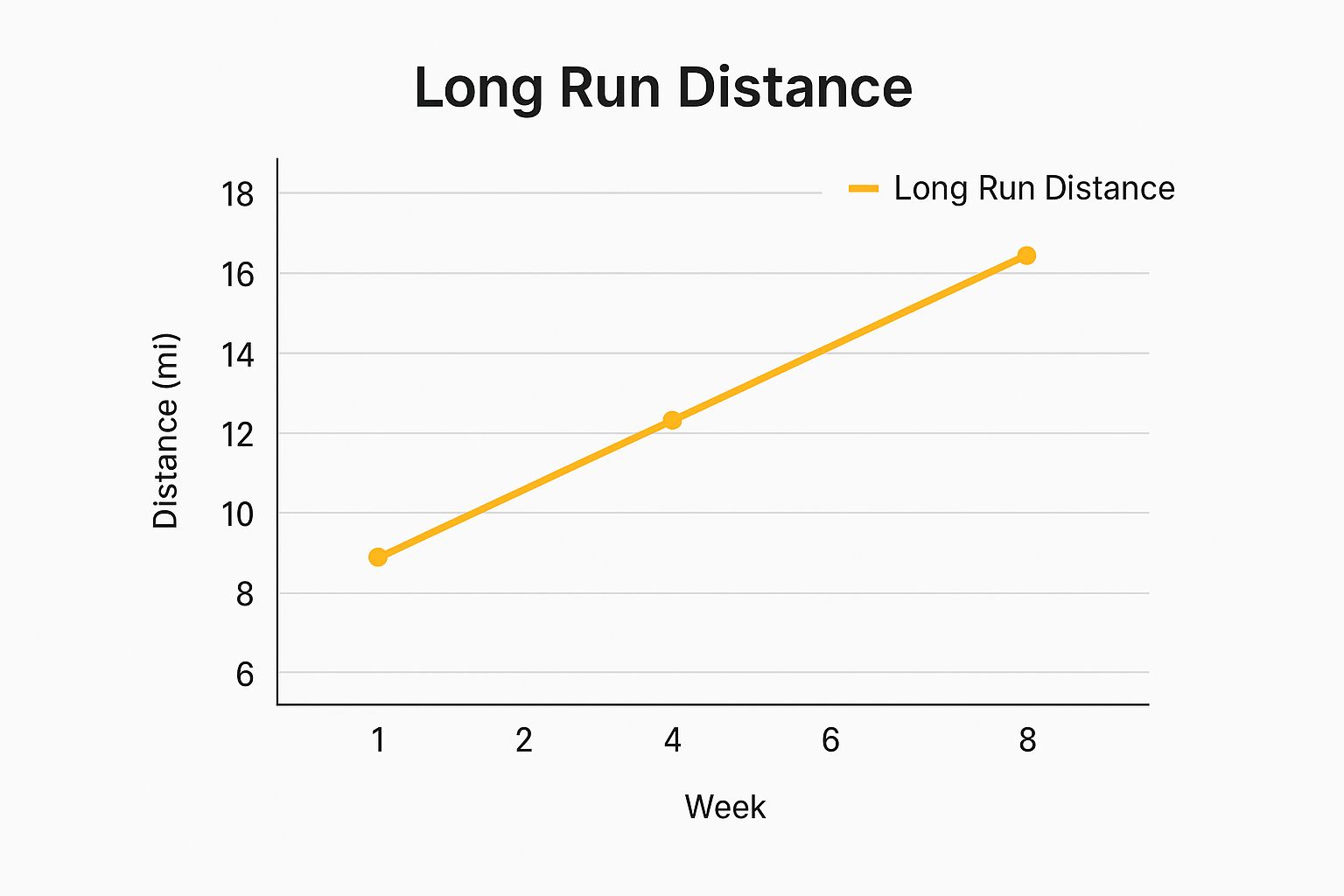Marathon Training Long Runs: The Ultimate Guide to Success
Why Long Runs Make or Break Your Marathon Success

Marathon training involves a careful blend of different run types, but the long run stands out as the most critical. These aren’t just about accumulating miles. They are the foundation of your marathon prep, gradually changing you both physically and mentally. This makes dedicating proper time and effort to your long runs essential for success.
Physiological Transformations: Building a Marathon-Ready Body
Long runs create specific adaptations in your body, vital for conquering the 26.2 miles. They primarily work your slow-twitch muscle fibers, the essential players in endurance events. These fibers become better at using oxygen and creating energy, letting you hold a faster pace for a longer duration.
Long runs also improve your body’s ability to burn fat as fuel. This is crucial for saving valuable glycogen stores and delaying the dreaded “hitting the wall.”
Furthermore, long runs boost mitochondrial density in your muscle cells. Mitochondria are the powerhouses of your cells, producing the energy needed for muscle contraction. A higher density means greater energy production, enhancing your overall endurance. This lets you run further and faster with less fatigue.
The Psychological Edge: Conquering the Mental Game
Beyond the physical advantages, long runs are key for developing the mental toughness needed for a marathon. They teach you to handle discomfort, push past fatigue, and stay focused for extended periods. This mental resilience is invaluable on race day when facing tough moments.
Consistently conquering longer distances also builds confidence and self-belief. Each completed long run is a win, reinforcing your ability to meet the demands of marathon training. This confidence translates into a positive mindset, a powerful motivator on race day.
Real-World Evidence: The Impact of Long Runs on Performance
The importance of long runs isn’t just theoretical; it’s supported by data. The London Marathon , known for its challenging course, provides compelling evidence. The average finish time improved considerably from 4:18:34 in 2022 to 4:06:39 in 2023, suggesting runners are training more effectively, possibly by including more strategic long runs.
Runners achieving faster times often logged significant mileage beforehand. Those finishing under 3:30 hours typically ran between 313 and 517 miles in the 16 weeks prior. This data underscores the significance of consistent and structured training, especially long runs, in achieving quicker marathon times. Ultimately, long runs are essential for preparing both your body and mind for the marathon’s unique challenges.
Crafting Your Perfect Long Run Progression

This chart shows a sample 8-week long run progression, building from 10 miles to 18 miles. The key takeaway here is the steady, gradual increase in distance. This approach is crucial for avoiding injuries and maximizing the benefits of your training. It allows your body to adapt to the increasing demands of marathon training without putting too much stress on your system. This gradual build-up is especially important for first-time marathoners.
Establishing Your Baseline and Building a Framework
The first step in planning your long run progression is figuring out your current long run distance. This is your baseline. Don’t feel pressured to start with huge mileage. Be realistic about your current fitness level. If your longest run is currently 8 miles, then that’s where you begin.
From your baseline, you can build a training framework. A good rule of thumb is to increase your long run distance by no more than 1-2 miles per week. This measured approach minimizes your risk of injury.
The Importance of Cutback Weeks and Peak Mileage
Running more miles every single week isn’t sustainable. Cutback weeks, where you decrease your mileage, are essential for letting your body recover and adapt. For example, every third or fourth week, try reducing your long run distance by 20-30%. This provides a valuable break for your body.
Also, think about your marathon goal time. While the classic “20-miler” is a popular benchmark, it might not be necessary for everyone. Your peak mileage will depend on your individual goals and experience level.
Timing is Everything: When to Hit Your Peak Long Run
The timing of your peak long run is also very important. Ideally, your longest run should be 3-4 weeks before race day. This gives you enough time to recover before the marathon. So, if your longest run is 18 miles, aim to complete it about a month before the race. You might be interested in: How to master running and weight training . This strategy ensures you’re well-rested and ready for the big day.
Adapting to Life’s Curveballs
Life happens. Be flexible and ready to adjust your long run schedule if illness, travel, or unexpected events disrupt your training. Don’t be afraid to shorten a long run or skip one if you need to. Listen to your body. It’s better to miss one long run than to risk an injury that could sideline you for weeks. Remember, consistency throughout your training cycle is more important than sticking rigidly to a plan.
The following table offers some example long run progressions based on different target finish times. It can help you get a sense of what an appropriate build-up might look like for your goal.
16-Week Marathon Long Run Progression
| Week | Sub-3:30 Distance | Sub-4:00 Distance | Sub-4:30 Distance | First-Timer Distance |
|---|---|---|---|---|
| 1 | 10 miles | 8 miles | 6 miles | 4 miles |
| 2 | 12 miles | 9 miles | 7 miles | 5 miles |
| 3 | 10 miles | 8 miles | 6 miles | 4 miles |
| 4 | 14 miles | 10 miles | 8 miles | 6 miles |
| 5 | 16 miles | 11 miles | 9 miles | 7 miles |
| 6 | 12 miles | 9 miles | 7 miles | 5 miles |
| 7 | 18 miles | 12 miles | 10 miles | 8 miles |
| 8 | 20 miles | 13 miles | 11 miles | 9 miles |
| 9 | 16 miles | 10 miles | 8 miles | 6 miles |
| 10 | 22 miles | 14 miles | 12 miles | 10 miles |
| 11 | 20 miles | 12 miles | 10 miles | 8 miles |
| 12 | 16 miles | 10 miles | 8 miles | 6 miles |
| 13 | 18 miles | 12 miles | 10 miles | 8 miles |
| 14 | 14 miles | 9 miles | 7 miles | 6 miles |
| 15 | 10 miles | 8 miles | 6 miles | 4 miles |
| 16 | Race Day | Race Day | Race Day | Race Day |
As you can see, building up gradually and incorporating cutback weeks are key elements in these plans, regardless of your target finish time. This allows for consistent progress while minimizing the risk of injury. Remember, this is just a sample progression and should be adjusted based on your individual needs and training experience.
Quality Vs. Quantity: Finding Your Long Run Sweet Spot

The marathon training world has a classic debate: high mileage or high-quality long runs? This question isn’t just for coaches and exercise physiologists; it directly affects your weekly training plan. The answer, like many training questions, depends on individual circumstances. Several factors help determine the best approach for your long runs.
Factors Influencing Your Long Run Strategy
Your age, how well you recover, past injuries, and available training time all contribute to figuring out your optimal long run distance. For example, a younger runner with lots of free time may benefit from higher mileage. An older runner with a history of injuries should prioritize the quality of their runs over how far they go.
Recovery isn’t constant, either. It changes based on stress, sleep, nutrition, and other daily factors. Your ideal long run distance may shift throughout your training. Paying attention to your body and adapting your training is key for long-term success. Learn more about adapting with a hybrid training program .
The Minimal Effective Dose: Training Smarter, Not Harder
Some elite runners thrive on 24-mile long runs, while others see great results with far less mileage. This highlights the idea of a “minimal effective dose”—the shortest long run that still gives you the training benefits without overdoing it. Interested in learning more? Check out this guide on hybrid training programs .
A study using Strava data from London Marathon runners shows this in action. Runners finishing under 3:00 averaged 621 miles over 16 weeks, 21% less than many plans suggest. This points towards quality-focused training as an effective approach.
Many UK runners use consistent, properly paced long runs to improve without tons of mileage. This can be especially helpful for runners with limited time or at higher risk of injury, helping them achieve competitive times in UK marathons. You can explore this topic further here .
Developing Your Personalized Long Run Framework
There’s no one-size-fits-all solution for long runs. It takes experimentation and paying attention to your own body. Start by honestly assessing your fitness level, how much time you have, and your risk of injury.
Then, gradually increase your long run distance, always keeping quality in mind. Regularly check in with yourself to see how your body responds to different lengths, and adjust your plan. Remember, the goal isn’t just about the miles; it’s about training smart and preparing for the specific challenges of a marathon.
Fuelling Strategies That Power Epic Long Runs
Marathon training requires serious dedication, and proper fuelling is key to conquering those long runs. This section dives into what your body needs before, during, and after these essential runs. We’ll cover the best carbohydrate choices, how to train your gut, and hydration strategies for the unpredictable British weather.
Pre-Run Fuel: Setting the Stage for Success
Before heading out, prioritize easily digestible carbohydrates. Excellent options include porridge, toast with jam, or a banana. These provide sustained energy without stomach upset. Aim to eat this meal roughly 2-3 hours before your run, allowing ample time for digestion and energy absorption. A smaller snack, like a rice cake with peanut butter, 30-60 minutes pre-run can provide a final energy boost.
During the Run: Maintaining Momentum
Keeping your energy up is vital during long runs. For runs exceeding 90 minutes, consider taking in fuel every 45-60 minutes to prevent glycogen depletion and the dreaded “hitting the wall.” Experiment with energy gels, chews, or even dried fruit to discover what suits you best. Carrying real food, like a piece of malt loaf, can provide a welcome change from sugary gels.
Hydration: Tailoring Your Strategy to British Weather
Hydration is crucial, especially given the UK’s ever-changing weather. Calculate your sweat rate by weighing yourself before and after a run, factoring in fluid intake. This helps determine your specific fluid needs. A kilogram of weight lost roughly equates to a litre of sweat. Electrolyte drinks become especially important in warmer weather to replace lost salts, while water might be sufficient in cooler conditions. Carry a hydration pack or water bottles to stay hydrated on the go.
Post-Run Recovery: Refuelling and Rebuilding
After a long run, prioritize refuelling and rehydration. Consume carbohydrates and protein within 30-60 minutes of finishing. Good options include a recovery shake, a glass of milk and a banana, or scrambled eggs on toast. This replenishes glycogen and helps repair muscles.
Training Your Gut: Avoiding Race Day Disasters
Practicing your nutrition strategy during training is essential to avoid race-day stomach problems. This helps your gut adapt to processing fuel while running. Gradually introduce different fuel sources on your long runs, paying attention to how your body responds. This helps identify potential issues and fine-tune your plan.
To help you plan your nutrition, here’s a quick guide for different long run durations:
Long Run Nutrition Guide Recommended fuelling strategies based on long run duration
| Run Duration | Pre-Run Nutrition | During Run Fuelling | Hydration Needs | Recovery Nutrition |
|---|---|---|---|---|
| < 60 minutes | Small snack (e.g., banana) | Water | Water as needed | Light snack |
| 60-90 minutes | Porridge, toast with jam | Water | Water, consider electrolytes | Recovery shake, small meal |
| 90+ minutes | Porridge, toast with jam, banana | Energy gels/chews every 45-60 mins | Water and electrolytes | Recovery shake, meal with carbs and protein |
This table offers a starting point for tailoring your nutrition plan. Remember to adjust based on your individual needs and experiences. By understanding and implementing these fuelling strategies, you can transform your long runs from a challenge into a source of strength, preparing you for a successful race day.
Long Run Pitfalls That Sabotage Marathon Dreams

Long runs are a cornerstone of marathon training. But knowing how to avoid common mistakes is just as important as logging the miles. Even small errors can have a surprisingly big impact. This section explores some frequent training traps that can derail marathon goals, even for seasoned runners.
Pace Strategy: The Tortoise and the Hare Revisited
Running long runs too fast is a common mistake. It’s easy to get carried away when you’re feeling strong. However, pushing the pace too early can lead to premature fatigue, undermining the endurance-building purpose of the long run. Remember the fable of the tortoise and the hare: slow and steady wins the race. Focus on time on your feet and building a solid aerobic base.
Many runners also overlook terrain specificity. If your marathon course includes hills, training exclusively on flat ground won’t adequately prepare you. This is especially important for UK marathons, often known for their varied terrain. Incorporating hills into your long runs builds the strength and resilience necessary for race day. Check out this resource on the Functional Movement Screen to help prepare your muscles for challenging terrain.
The “Too Much, Too Soon” Trap: A Recipe for Injury
Increasing mileage too quickly is another common pitfall. The “too much, too soon” principle applies to marathon training in several ways. This includes sudden increases in weekly mileage and ramping up the distance of individual long runs too rapidly. Overstressing muscles and joints in this manner is a surefire recipe for injury.
Recovery: More Than Just Rest
Recovery is arguably the most crucial element of marathon training—and often the most neglected. Many runners have recovery protocols that actually hinder adaptation. This can involve insufficient rest days, neglecting proper nutrition, or skipping important activities like stretching and foam rolling. Inadequate recovery increases injury risk and limits the body’s ability to adapt to the training load.
Proper footwear is another key factor. Even seemingly small footwear choices can have a major cumulative effect over a long training period. Ill-fitting or inappropriate shoes can cause discomfort and even injury. Make sure you have the right shoes for your foot type and running style.
According to Runner’s World , the average marathon finish time for men in the UK is 4:23:27. Understanding this benchmark can help you set realistic goals and tailor your training accordingly. This is particularly important for structuring your long runs effectively and working toward your target marathon pace.
By being aware of these potential pitfalls, you can stay on track, minimize risks, and maximize your training. Avoiding these common traps will help you cross the finish line stronger and more prepared.
Advanced Long Run Workouts That Elevate Performance
Moving beyond standard long runs is key to unlocking peak marathon performance. Strategically varied workouts during your marathon training long runs can build both endurance and speed, crucial for conquering the 26.2 miles. Think of it like preparing for a big exam—simply rereading your notes isn’t enough. You need to test yourself with different question formats to truly master the material. Similarly, diverse long run workouts prepare your body and mind for the varied challenges of race day.
Progressive Long Runs: Building Strength Through Fatigue
Progressive long runs involve gradually increasing your pace throughout the run. For example, start at an easy conversational pace and increase the speed every few miles, finishing at your target marathon pace or slightly faster.
This workout teaches your body to maintain good form even when fatigued, simulating the latter stages of a marathon. This is particularly important for UK marathons, which can have unpredictable weather conditions adding to the challenge.
Fast-Finish Long Runs: Developing Mental Toughness
Fast-finish long runs focus on finishing strong. Run the first two-thirds of your long run at an easy pace, then pick up the speed for the final third.
This simulates the mental toughness required to push through fatigue in the final miles of a marathon. It’s not just about physical endurance; it’s about developing the mental fortitude to keep going when your body wants to stop. This is valuable preparation for those tough moments in a race.
Simulation Runs: Tailoring Your Training to the Course
Simulation runs involve mimicking your target marathon course as closely as possible. This might mean incorporating similar elevation changes, terrain types, or even weather conditions. If your target marathon has lots of hills, like many UK marathons, include hill training in your long runs.
This specificity helps your body adapt to the demands of the specific course and avoids unpleasant surprises on race day. It’s like practicing exam questions in the same format as the real test—it builds confidence and sets expectations.
Hill-Focused Long Runs: Conquering UK Terrain
Hill-focused long runs are particularly relevant for UK races, which often feature challenging climbs. These runs involve including significant hill work during your long runs.
This doesn’t necessarily mean running up and down a single hill repeatedly. Instead, structure your long run to include several rolling hills, gradually increasing the elevation gain. This approach builds strength and improves running efficiency on hilly terrain.
Alternating Pace Long Runs: Enhancing Speed Endurance
Alternating pace long runs involve alternating between faster and slower paces. For example, you could run one mile at your target marathon pace followed by one mile at an easy recovery pace.
This approach develops speed endurance, the ability to maintain a faster pace over a longer period. This type of training can be especially beneficial for more experienced runners looking to improve their performance. It’s similar to interval training , but integrated into your long runs to build race-specific fitness. Each of these advanced long run variations offers unique benefits for marathon preparation. Implementing them strategically within your training plan can significantly elevate your performance and prepare you for race day.
Recovery Mastery: Maximizing Long Run Adaptations
Marathon training long runs are truly demanding, pushing your body to its absolute limits. But the real magic happens afterward, in the recovery phase. This is where the adaptations from those hard-earned miles truly take hold, increasing your strength and resilience. However, inadequate recovery can hinder your progress, leading to frustrating plateaus or even injuries. This section explains how to optimize the 48 hours after your long runs, transforming your recovery into a true performance enhancer.
Refueling and Repair: Timing is Key
Immediately after a long run, your body is depleted of glycogen, the primary fuel source for your muscles. This is the crucial window for replenishing these stores and jumpstarting muscle repair. Aim to consume a combination of carbohydrates and protein within 30-60 minutes of finishing. This could be a simple recovery shake, a glass of milk and a banana, or even scrambled eggs on toast.
This quick replenishment isn’t just about restoring energy. It’s vital for reducing muscle soreness and inflammation, preparing you for your next training session. This is especially important during marathon training, where consistent progress is key.
Hydration: Adapting to the UK Climate
Hydration is essential for recovery, particularly in the unpredictable UK climate. Cooler, damper conditions can mask fluid loss through sweat, making dehydration a hidden danger. Don’t rely on thirst alone – it’s often a delayed indicator. Develop a personalized hydration plan based on your individual sweat rate and adapt it to the weather.
Consider using electrolyte drinks, especially during warmer weather or after particularly tough long runs. These drinks replace essential minerals lost through sweat, further aiding recovery. For a more personalized approach, check out: How to master a personalized training program .
Active Recovery and Mobility: Enhancing Circulation
While rest is important, active recovery can greatly improve your recovery process. Gentle activities like walking or cycling improve blood flow, removing metabolic waste products that build up during intense exercise. This improved circulation delivers oxygen and nutrients to your muscles, speeding up repair and lessening soreness.
Also, make time for mobility work, such as foam rolling and stretching. This helps relieve muscle tightness, improve range of motion, and prevent post-run stiffness. These practices are especially helpful for areas prone to tightness after long runs, like the upper back. Research shows poor posture, particularly when fatigued, contributes to upper back pain after running. Maintaining good posture and gaze during your run, coupled with post-run breathing exercises and strength training focused on rib mobility, can lessen this pain.
Monitoring Recovery Status: Listening to Your Body
Recovery is a personal journey. It’s important to develop a system for monitoring your own recovery status. This might involve tracking metrics like resting heart rate, sleep quality, and perceived muscle soreness. Pay attention to these signals from your body, as they offer valuable insights into your recovery status.
Learning to distinguish between normal post-run tiredness and signs of overtraining is essential. If you experience persistent fatigue, prolonged muscle soreness, or declining performance, it might be a sign you need more recovery time. Sometimes an extra easy day yields better long-term results than pushing through fatigue. By mastering recovery, you transform it from a passive process into a proactive strategy, maximizing your long run adaptations and paving the way for peak performance.
Table of Contents
- Why Long Runs Make or Break Your Marathon Success
- Physiological Transformations: Building a Marathon-Ready Body
- The Psychological Edge: Conquering the Mental Game
- Real-World Evidence: The Impact of Long Runs on Performance
- Crafting Your Perfect Long Run Progression
- Establishing Your Baseline and Building a Framework
- The Importance of Cutback Weeks and Peak Mileage
- Timing is Everything: When to Hit Your Peak Long Run
- Adapting to Life’s Curveballs
- Quality Vs. Quantity: Finding Your Long Run Sweet Spot
- Factors Influencing Your Long Run Strategy
- The Minimal Effective Dose: Training Smarter, Not Harder
- Developing Your Personalized Long Run Framework
- Fuelling Strategies That Power Epic Long Runs
- Pre-Run Fuel: Setting the Stage for Success
- During the Run: Maintaining Momentum
- Hydration: Tailoring Your Strategy to British Weather
- Post-Run Recovery: Refuelling and Rebuilding
- Training Your Gut: Avoiding Race Day Disasters
- Long Run Pitfalls That Sabotage Marathon Dreams
- Pace Strategy: The Tortoise and the Hare Revisited
- The “Too Much, Too Soon” Trap: A Recipe for Injury
- Recovery: More Than Just Rest
- Advanced Long Run Workouts That Elevate Performance
- Progressive Long Runs: Building Strength Through Fatigue
- Fast-Finish Long Runs: Developing Mental Toughness
- Simulation Runs: Tailoring Your Training to the Course
- Hill-Focused Long Runs: Conquering UK Terrain
- Alternating Pace Long Runs: Enhancing Speed Endurance
- Recovery Mastery: Maximizing Long Run Adaptations
- Refueling and Repair: Timing is Key
- Hydration: Adapting to the UK Climate
- Active Recovery and Mobility: Enhancing Circulation
- Monitoring Recovery Status: Listening to Your Body